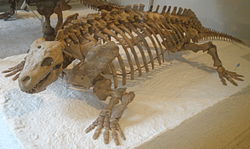Diadectes
|
Diadectes Temporal range: Cisuralian 290–272 Ma |
|
|---|---|
 |
|
| Mounted skeleton of D. sideropelicus, American Museum of Natural History | |
| Scientific classification | |
| Kingdom: | Animalia |
| Phylum: | Chordata |
| Order: | †Diadectomorpha |
| Family: | †Diadectidae |
| Genus: |
†Diadectes Cope, 1878 |
| Type species | |
|
Diadectes sideropelicus Cope, 1878 |
|
| Species | |
|
D. lentus (Marsh, 1878) |
|
| Synonyms | |
|
Nothodon Marsh, 1878 |
|
D. lentus (Marsh, 1878)
D. sideropelicus Cope, 1878
D. tenuitectus Cope, 1896
D. carinatus (Case & Williston, 1912)
D. absitus Berman et al., 1998
Nothodon Marsh, 1878
Empedocles Cope, 1878
Helodectes Cope, 1880
Empedias Cope, 1883
Chilonyx Cope, 1883
Bolbodon Cope, 1896
Diadectoides Case, 1911
Animasaurus Case & Williston, 1912
Diadectes (meaning crosswise-biter) is an extinct genus of large, very reptile-like amphibians that lived during the early Permian period (Cisuralian epochs, between 290 and 272 million years ago). Diadectes was one of the very first herbivorous tetrapods, and also one of the first fully terrestrial animals to attain large size.
Diadectes was a heavily built animal, 1.5 to 3 meters long, with a thick-boned skull, heavy vertebrae and ribs, massive limb girdles and short, robust limbs. The nature of the limbs and vertebrae clearly indicate a terrestrial animal.
It possesses some characteristics of reptilians and amphibians, combining a reptile-like skeleton with a more primitive, seymouriamorph-like skull. Diadectes has been classified as belonging to the sister group of the amniotes.
Among its primitive features, Diadectes has a large otic notch (a feature found in all labyrinthodonts, but not in reptiles) with an ossified tympanum. At the same time its teeth show advanced specialisations for an herbivorous diet that are not found in any other type of early Permian animal. The eight front teeth are spatulate and peg-like, and served as incisors that were used to nip off mouthfuls of vegetation. The broad, blunt cheek teeth show extensive wear associated with occlusion, and would have functioned as molars, grinding up the food. It also had a partial secondary palate, which meant it could chew its food and breathe at the same time, something many even more advanced reptiles were unable to do.
...
Wikipedia
